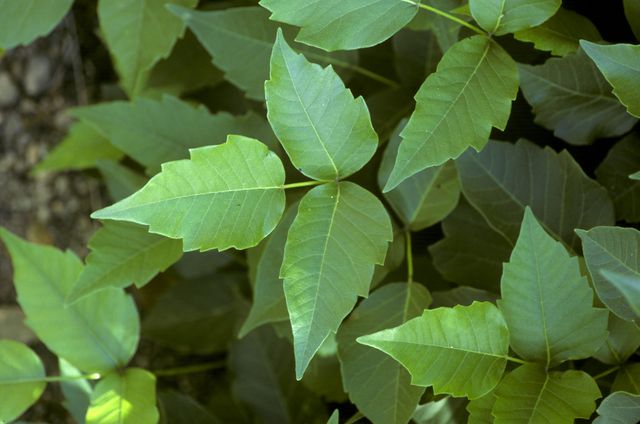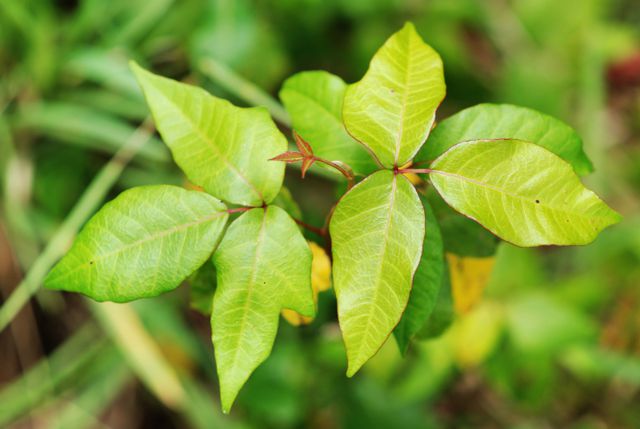How a Horticulturist Really Kills Poison Ivy
Some methods work better than others to get rid of poison ivy permanently.
Key Takeaways
- Fast-growing poison ivy vines can grow 20 feet each season along fence lines and in landscaped beds.
- Several methods work to get rid of poison ivy, including chemicals and pulling it up, though it may take repeat treatments to fully eradicate it.
- When removing and disposing of poison ivy, take proper care to protect your skin from contact with the plant.
What makes poison ivy a much dreaded plant is urushiol, an oily resin that, upon contact with the skin, can result in contact dermatitis, often presenting as a red, itchy rash with blisters or bumps. Poison ivy is particularly concerning in areas where children play, as they likely will not know how to differentiate it from other innocuous plants. Pets roaming around the plants also pose a high risk, as they transmit the oily resin to humans through their fur.
If you suspect you have poison ivy in your yard, there are a few key indicators to identify it. It is key to eradicate poison ivy early before it becomes a problem.
Here, a weed control expert weighs the pros and cons of different ways to get rid of poison ivy and shares the most effective way to kill poison ivy effectively and permanently.

Where Poison Ivy Grows
Poison ivy is a perennial vine or woody shrub. It grows in woodlands, forest edges, and along lakes and rivers. It is native throughout the U.S. and parts of Canada. As a vine, poison ivy grows by aerial rootlets that help it reach lengths of 60-150 feet, climbing along fences, walls, and trees. As a shrub, it grows to a height of 6 feet.
The plant grows during spring and summer, with foliage turning red, orange, or yellow in the fall before dropping. Even when it is leafless, it is still poisonous.
Poison ivy grows quickly. Vines may grow as much as 20 feet in a single season. “Poison ivy is a notorious climber and spreads laterally across the ground, in addition to climbing on vertical surfaces, ” says John Kauffman, Ph.D., research scientist at TruGreen . “It is found along fence lines, in wood piles, and your landscape beds. Thankfully, poison ivy doesn’t tolerate regular mowing and isn’t often found in maintained lawns."

How To Identify Poison Ivy
“Poison Ivy is probably best identified by its trifoliate leaves, which are a compound leaf made of three leaflets (hence, the old rhyme ‘leaves of three, let it be’),” explains Kauffman. “They are attached to petioles (leaf stalks) that are red in color and may be hairy on older plants.” To identify the plant, Kaufmann recommends looking for a notch or lobe that is sometimes found on one side of the oblong leaflets with smooth margins.
If you know what you’re looking for, it is possible to avoid poison ivy. However, it is best to eliminate the problem in case those who aren’t as well-informed find themselves near the vine.
How To Kill And Get Rid Of Poison Ivy
Depending on the method you choose, eradicating poison ivy from your yard may take patience and repeated treatments. Here are different methods of getting rid of poison ivy and their pros and cons:
Tips
When handling poison ivy, don’t neglect your gear. To protect you from getting exposed to the oil, wear long pants tucked into boots or thick socks and close-toed shoes, rubber gloves, and long sleeves.
Boiling Water
Some gardeners drench the plant with boiling water, a method that is usually not effective in killing the entire plant. “Boiling water may kill back some of the aboveground tissues, but it doesn’t affect the plant crown or roots, which will re-sprout new shoots after the initial scalding,” Kauffman says. “Also, the leaf tissue that remains after scalding still contains urushiol on its surface, and touching it could cause an itchy reaction.”
Herbicides
To get rid of poison ivy permanently, conventional weedkillers (herbicides) are your best bet. Either use 3-way herbicides that contain a combination of the active ingredients dicamba, mecoprop, and 2,4-D amine, or herbicide products with triclopyr or glyphosate. These synthetic chemicals are the most effective and fastest way to completely eliminate poison ivy, although large infestations may require more than one application.
Whichever chemical route you take, Kauffman urges home gardeners to read all labels and directions thoroughly before use. “Some products that control poison ivy may injure your desirable landscape plants if sprayed directly onto them,” he warns. “Other products may injure your lawn grass, so it’s important to read the label and follow the directions carefully.”
The best time to spray poison ivy is on a sunny, calm day when temperatures are between 60°F and 85°F and no rain is in the forecast.
Here's how to spray poison ivy:
- If treating a low-growing carpet of poison ivy, thoroughly soak all leaves of small plants while spraying, making sure not to spray or let the herbicide drift onto desirable plants. Take the direction of the breeze into account when spraying.
- Cut mature vines 2 or 3 feet above ground with pruners or a pruning saw (make sure you are wearing gloves when you do this). Paint cut edges with the herbicide.
After applying herbicide, wash your tools in soapy water, using a grease-cutting dish detergent and a scrub brush. Rinse and dry. Alternatively, wipe blades with rubbing alcohol. Wear waterproof dish gloves when cleaning your tools.
Sometimes new leaves sprout from the stumps of vines. Reapply the spray on new foliage until no more regrowth appears.
Follow the same steps to permanently get rid of poison oak, the counterpart of poison ivy in the western part of the United States.
Homemade Weed Killer
Homemade treatments are appealing if you are trying to avoid powerful chemicals, but Kauffman expresses doubts about their effectiveness. “ DIY weed killers may not work consistently across a variety of conditions, and they may have difficulty with persistent species like poison ivy,” he says.
For that reason, he prefers treatments that leave little to chance. Homemade weed killer is easy to make with things you have in your pantry, but it is not very effective at removing poison ivy. It kills the leaves but not the roots, and the poison ivy will grow back.
Pulling
“Poison Ivy can be pulled if it’s small, but it is difficult to fully extract all the underground tissues,” explains Kauffman. “It is also risky because when you touch the plant, the oil resin might get onto your skin.”
If you’ve already used another method for killing poison ivy and the plant is both brown and dry, manual removal may help clear it out once and for all (hopefully).
Removal by pulling is an alternative to chemical methods only if you are dealing with a small plant. It is not a suitable option for large infestations.
Here's how to pull poison ivy:
- Start by clipping off any above-ground stems using sharp shears. Tearing apart the stems or ripping them could make the toxic resin airborne.
- Dispose of plant parts in heavy-duty yard waste bags.
- Dig out the roots using a small hand shovel before properly disposing of the roots in a yard waste bag.
Smothering
Smothering poison ivy is all about blocking off both light and oxygen sources the plant uses to thrive. Kauffman warns that it has limited effectiveness due to the nature of the plant. “Poison ivy is well adapted to shaded conditions and situations where other plants may grow overtop of or shade out poison ivy.”
Here's how to smother poison ivy:
- Cover the poison ivy with a large plastic tarp and leave it in place for a week.
- Check to see if the plant is brown and dry. If so, pull the dead weed using the process described in the Pulling section above. If it’s not there yet, replace the tarp and give it another few days to a week.
- If you’re still not seeing any changes, you might want to consider another method.
How To Dispose Of Poison Ivy Safely
There is only one safe way to dispose of poison ivy remnants—in the trash. Both burning and composting should be entirely avoided. “Do not burn poison ivy, since the urushiol travels with the smoke and causes breathing irritation,” warns Kauffman. And don’t add it to your compost as the urushiol persists.
Regardless of which removal method you use, here is how to dispose of poison ivy properly and safely:
- Protect yourself with gloves, long sleeves, pants, and shoes.
- Rake up any poison ivy debris and place it in a thick yard waste bag, says Kaufmann.
- Dispose of the bags with the rest of your yard waste.
Frequently asked Questions
Does vinegar really kill poison ivy?
No, vinegar does not kill poison ivy. Household vinegar, which is rather weak (5% acetic acid), does not travel to the roots. Herbicidal vinegar has higher concentrations but works best on small annual broadleaf weeds.
Are there any pros to poison ivy?
While it is a nuisance for humans, poison ivy is a native plant with wildlife value. It provides food (berries) and shelter for birds, mammals, reptiles, and insects throughout the year.
Can you get poison ivy from contaminated clothing?
Yes, the oil resin sticks to contaminated clothing. Do not touch it with your bare hands; instead, put on disposable rubber gloves when removing your clothing and place it in a large plastic bag. Dump the clothing from the plastic bag into the washing machine and wash it in the hottest water temperature that is safe for the fabric, using regular detergent.
What's the difference between Virginia creeper and poison ivy?
Virginia creeper ( Parthenocissus quinquefolia ) is often mistaken for poison ivy. Virginia creeper has five leaves, while poison ivy has three. The vine of Virginia creeper is smooth, not hairy like poison ivy vines. Though it may also irritate the skin, Virginia creeper doesn’t cause a painful rash like poison ivy does.
Read the original article on Southern Living
Post a Comment for "How a Horticulturist Really Kills Poison Ivy"
Post a Comment